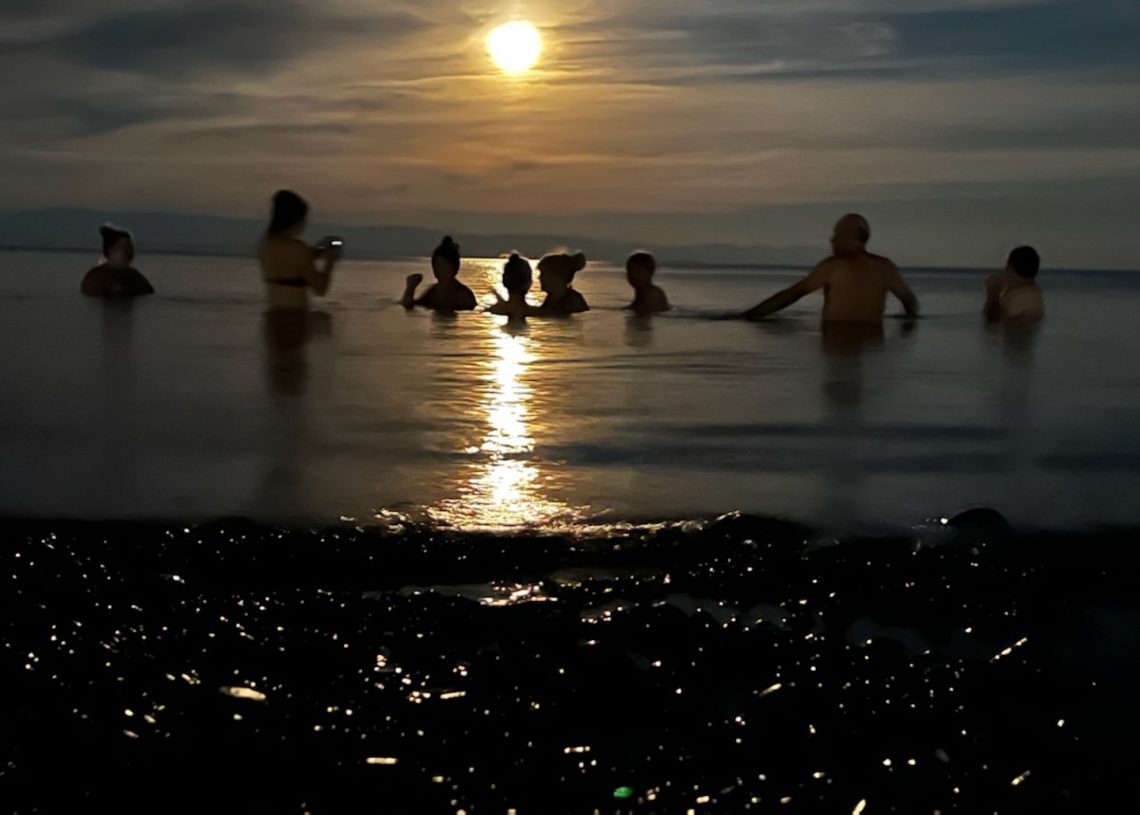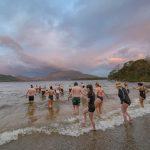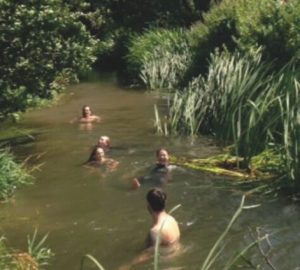
Like the birds in the sky
In this beautiful ode to cold-water swimming, Canadian reader Glenda Bonne ponders on what draws her and other “like-minded crazy people” into the chilly waters of the Salish Sea
A flock of birds fly in perfect formation high in the blue sky as we sit on the beach. They swoop and dive and move in total synchronization with each other. As we watch them, questions arise: How do they do it? Why do they do it? We puzzle over these mysteries for awhile and then realize -we don’t really need to know the answers. This moment in nature is complete as it is.
And as we continue to sit on the shore pondering this conclusion, my husband and I realise that there is another event happening in our lives that is just as awe-inspiring. Without planning, almost even without conscious thought, we have begun a new endeavour. It’s a new experience that is beyond our desire to explain or question.
We have become plungers, dippers, cold water swimmers. Or, as most of my friends and family believe, crazy people.
It just happens
So how, like the perfect aerial formation above us, did this happen? And why? Well, again, we find we don’t care about the mechanics of it. We don’t analyse it too deeply. It just seems we have received a gift and we’re not going to ask questions. We started one day and it just went from there.
And how is it, you ask? Well, it’s challenging. But it is also stimulating, exciting and just downright fun. It is, as the saying goes, the thrill of the chill.
It’s called by many names: Cold Water Therapy, ocean swimming, a dip, a dunk, a plunge, a swim. Basically, we (a constantly growing group of self-named like-minded crazy people) have come together to regularly and willingly go as a group into the waters of the Pacific Ocean. We are all shapes and sizes, all ages, and all genders. We are joined together by a love of the dip, the bigger than life sensation and the excitement of it all. But we get ahead of ourselves. Let’s talk about how we do this thing.
Every second day or so, we gather at the water’s edge in nearly every weather. We sometimes have to go to two or three different locations searching for the safest conditions. As you can imagine, our waters (a section of the Pacific Ocean off the east coast of Vancouver Island known as the Salish Sea) can get very rough with huge waves, surf, rollers and logs bashing against the shore. When conditions are like this, the group moves en masse like the synchronised birds to a new, safer location. Upon finding that day’s ideal spot, we settle on the beach and begin our chatter.
Preparing ourselves
For that’s at least half of it – our camaraderie. We gather, we talk, we joke. For the first while, we dawdle, swathed in our warm clothes and standing around a small fire for visits and conversation. It’s a lovely surreal time. Here we are, on a beach in the middle of a Canadian west coast winter, dressed in ridiculous outfits, talking and watching the water.
Now we are analysing. Are those waves too big? Is there driftwood out there that could be dangerous? Is the wind too strong, just right or not strong enough to be exciting? All the elements are discussed and the experience starts to unfold.
Slowly, everybody is setting up their spot on the sand, spreading out towels and mats, getting primed for a big thrill. Warm clothing is coming off but not too quickly so as not to get prematurely chilled. Heart rates are going up, adrenaline is beginning to pump and we are almost ready. Finally, someone says, ok, let’s do this and suddenly, it’s time. The last garments are dropped on the sand leaving us shivering in just bathing suits, toques, gloves and water boots. Finally, it begins.
The first swimmers to arrive at the edge of the water lead the pack. We are all nervous, laughing, and ready for a shock. Some people race in and fall forward right into the frigid water. For those of us that do it like that, we know that if we stood still and thought about it, we wouldn’t get in at all.
Embracing the cold
Others go slowly and gracefully sink into what feels like melted ice. And some go waist deep and stand, frozen but determined, waiting for the moment they can make themselves immerse. It’s a beautiful thing, this immersion, and everyone does it in their own way. Bravely, we all try our best to do what we can.
And after a while that cold shock becomes, surprisingly, minimal. Momentary. The water slides over the body, the weight disappears and the adrenaline seems to pump to every cell. If there are waves, they cause many of us to whoop and scream and yell and laugh and we are in ecstasy . We are getting absolutely numb, tingling, smiling and having a great time. Happy – making chemicals are released in our brains and soon we are all enjoying ourselves immensely.
And now, a second round of socializing begins. We are in freezing water up to our necks but we are talking and passing the time of day as if we are at a bus stop with nothing else to do. We laugh, we move, and some of us swim a bit. Then, after five or six minutes, a slow exodus starts.
The length of time we have been immersed is loudly called out by someone with enough common sense to watch a clock (5 minutes! 10 minutes!) and the first of us start to slowly move our bright red, numb bodies towards the shore. If the waves are big, we are pushed or maybe thrown laughingly to the beach but however it occurs, it becomes a parade. One person gets out, followed by another and another until, after the last person has remained in the water as long as they wish, we are all back on the beach and moving up to the logs and the fire.
A warming ritual
Reaching our designated spot, we each begin the process of quickly, so quickly, drying off and putting our fleeces, our hoodies and all our other comforting clothes back onto our unfeeling bodies.
And that is yet another ritual: that of dressing after a cold water dip. It’s practically a religion, this deliberate dressing in a way that will keep hypothermia at bay. Dry off quickly, as fast and efficiently as possible. Put on your huge swim cape and take off that wet freezing bathing suit underneath it. Put on your warmest pants, a very warm top, socks, and maybe a dry toque and do it all while somehow displaying a minimum of bare frozen skin to the world. Then hang out at the fire for a while.
At this point, yet another round of talking and laughing begins, but now it is punctuated by a bit of shivering coupled with a touch of urgency. It will not do to linger too long because, after approximately five minutes, the blood starts rushing to the core and our extremities are getting cold, very cold. Left untended, our bodies would rebel and we could experience anything from discomfort to full blown hypothermia. And so we move quickly, talk less and finally stuff all our things into a big bag.
Until next time
We shake off the sand, bid each other adieu, mumble about a date for the next time and stumble to our cars. My husband and I pour hot sweet tea into warm ceramic cups in the car and drink and drive all the way home. We gulp some chocolate or cake and awkwardly move into the house, occasionally shaking right to the core. Move, move! March around the house, run a warm bath, get off the rest of the wet clothes and do anything else to get warm. Time it all correctly so as not to cause a heart attack from the difference in temperature, but for sure, do something to get rid of that chill.
And with the gradual, blessed warming up of the bones and core and all other body parts comes contentment. We did it again. What an accomplishment. With our brains still secreting endorphins, we are high and filled with a sense of peace. Mental health is restored, worries are set aside and the next few hours pass in a happy haze. Like the birds in the sky, we have done an amazing, inexplicable thing and we are so happy and proud.
And still, the questions of how we do it and why we do it are still irrelevant and unnecessary. Instead, we happily ask ourselves the only really important remaining thing…
When can we do it again?
If you’d like to join Glenda and her friends for regular sea dips, you can get in with Glenda via email.
Read more of our readers’ swim stories.








